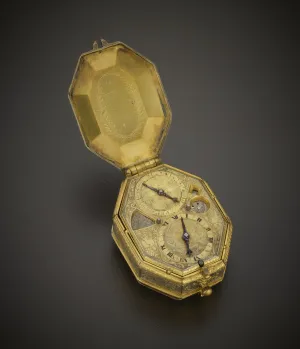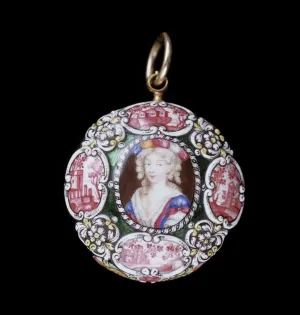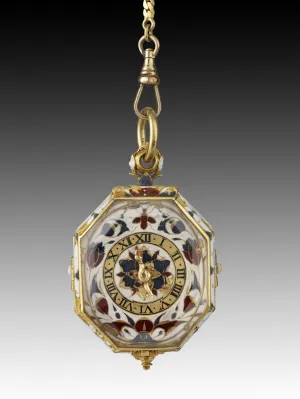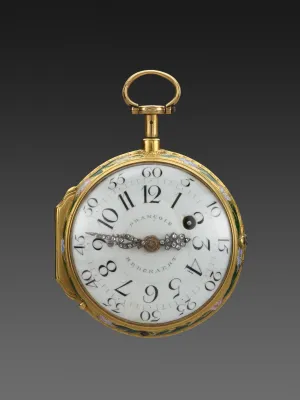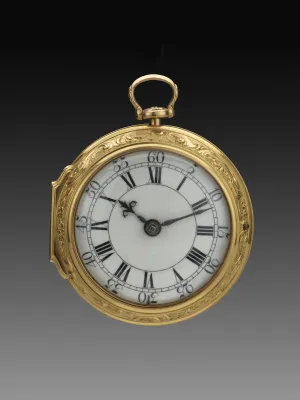Watches
Watches were introduced in the mid-sixteenth century following the refinement of spring-driven clocks. However, they became accurate only after 1675, when the balance spring was introduced. They were valued primarily as luxury items and their cases were of various materials, shapes, and forms, decorated in different techniques reflecting the fashion and tradition of the country where they were made and the personal taste and wealth of their owner.
During the late seventeenth and eighteenth centuries, the most sought-after watches were decorated with miniature paintings on enamel. The technique was developed in Blois around 1630 but soon evolved in Geneva, thanks to Pierre Huaud, a Protestant who had fled France and established himself in Switzerland in the early seventeenth century. His eldest son, Pierre Huaud II, decorated the case for an early balance-spring watch made in Switzerland circa 1685 by Henry Arlaud. The enamel on the back is inspired by an engraving after The Toilet of Venus by the French artist Simon Vouet (1590−1649).
Gold watches were coveted throughout Europe. In England around 1750, repoussé (the ancient art of hammering the underside of a piece of metal to create a design on its surface) was in fashion for luxury watches. John Gastrill mastered the technique on a case for a watch by Thomas Mudge, one of the greatest watchmakers of eighteenth-century England.
George Smith (active c. 1622−after 1646)
Silver Calendrical and Astronomical Pendant Watch
London, c. 1625
silver gilt, gilt brass and steel on brass
2 7/16 x 1 7/16 x 1 in. (6.2 x 3.6 x 2.5 cm)
Bequest of Winthrop Kellogg Edey, 1999
Accession number: 1999.6.17
Chavannes le Jeune (active c. 1650−1660)
enameling attributed to Pierre Huaud (1612−1680)
Gold and Enamel Pendant Watch
Geneva, c. 1660
gold and enamel on brass
1 7/8 x 1 5/16 x 1 1/4 in. (4.7 x 3.3 x 3.2 cm)
Bequest of Winthrop Kellogg Edey, 1999
Accession number: 1999.6.21
Henry Arlaud (1631−1689)
enameling by Pierre Huaud II (1647−c. 1698)
Gold and Enamel Pendant Watch
Geneva, c. 1685
case and movement displayed separately
2 5/16 x 1 5/8 x 15/16 in. (5.9 x 4.1 x 2.4 cm)
Bequest of Winthrop Kellogg Edey, 1999
Accession number: 1999.6.22
C. de Lespée (dates unknown)
Gold, Rock Crystal, and Enamel Pendant Watch
case and movement displayed separately
Reims, c. 1620
gold and cloisonné enamel on rock crystal
2 5/8 x 1 9/16 x 1 1/16 in. (6.6 x 3.9 x 2.8 cm)
Bequest of Winthrop Kellogg Edey, 1999
Accession number: 1999.6.18
François Beeckaert (master in 1746)
Gold and Enamel Repeating Verge Watch
Paris, 1750−55
gold and enamel on gold
Bequest of Winthrop Kellogg Edey, 1999
Accession number: 1999.6.25
Julien Le Roy (1686−1759)
Gold and Enamel Pocket Watch
case and movement displayed separately
Paris, c. 1750
gold and enamel on gold
2 1/4 x 1 3/4 x 1 3/4 in. (5.8 x 4.5 x 4.4 cm)
Bequest of Winthrop Kellogg Edey, 1999
Accession number: 1999.6.24
Thomas Mudge (1715−1794)
chaser and casemaker John Gastrill (active 1757−66)
Gold Repoussé Pocket Watch
London, 1757
gold and enamel on brass
2 3/8 x 1 15/16 x 1 3/4 in. (6 x 4.9 x 4.4 cm)
Bequest of Winthrop Kellogg Edey, 1999
Accession number: 1999.6.26

